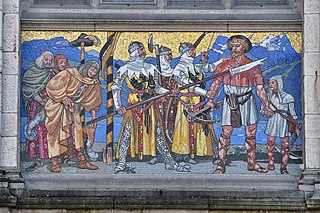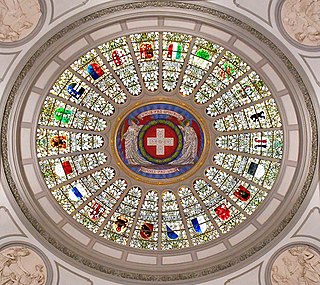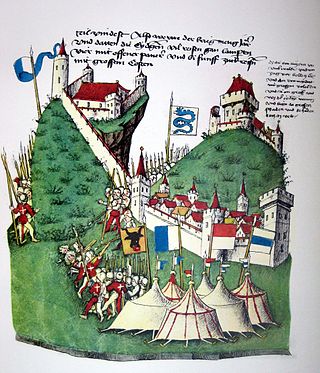
Since 1848 the Swiss Confederation has been a federal republic of relatively autonomous cantons, some of which have a history of federation that goes back more than 700 years, putting them among the world's oldest surviving republics.

Unterwalden, translated from the Latin inter silvas(between the forests), is the old name of a forest-canton of the Old Swiss Confederacy in central Switzerland, south of Lake Lucerne, consisting of two valleys or Talschaften, now two separate Swiss cantons, Obwalden and Nidwalden.

Obwalden or Obwald is one of the 26 cantons forming the Swiss Confederation. It is composed of seven municipalities and the seat of the government and parliament is in Sarnen. It is traditionally considered a "half-canton", the other half being Nidwalden.

Sarnen is a small historic town, a municipality, and the capital of the canton of Obwalden situated on the northern shores of Lake Sarnen in Switzerland. It has a population of just over 10,000 and is surrounded by countryside and mountains. Sarnen is located 20 km south of Lucerne.

Nidwalden or Nidwald is one of the 26 cantons forming the Swiss Confederation. It is composed of eleven municipalities and the seat of the government and parliament is in Stans. It is traditionally considered a "half-canton", the other half being Obwalden.

William Tell is a folk hero of Switzerland. According to the legend, Tell was an expert mountain climber and marksman with a crossbow who assassinated Albrecht Gessler, a tyrannical reeve of the Austrian dukes of the House of Habsburg positioned in Altdorf, in the canton of Uri. Tell's defiance and tyrannicide encouraged the population to open rebellion and a pact against the foreign rulers with neighbouring Schwyz and Unterwalden, marking the foundation of the Swiss Confederacy. Tell was considered the father of the Swiss Confederacy.

Each of the 26 modern cantons of Switzerland has an official flag and a coat of arms. The history of development of these designs spans the 13th to the 20th centuries.

Engelberg Abbey is a Benedictine monastery in Engelberg, Canton of Obwalden, Switzerland. It was formerly in the Diocese of Constance, but is now in the Diocese of Chur. It is dedicated to Our Lady of the Angels and occupies a commanding position at the head of the Nidwalden Valley.
The Sachseln Tunnel is a tunnel in the Swiss canton of Obwalden. It runs to the south-east of the Lake of Sarnen between Giswil and Sarnen, bypassing the old road along the lake side, and forms part of the A8 motorway. The tunnel was completed in 1997 and is 5,231 metres (17,162 ft) long.

The Rütli Oath is the legendary oath taken at the foundation of the Old Swiss Confederacy by the representatives of the three founding cantons, Uri, Schwyz and Unterwalden, It is named after the site of the oath taking, the Rütli, a meadow above Lake Uri near Seelisberg. Recorded in Swiss historiography from the 15th century, the oath is notably featured in the 19th century play William Tell by Friedrich Schiller.

Lake Sarnen is a lake in the Swiss canton of Obwalden. The lake is on the Sarner Aa, which flows out of the Lake Lungern, through the Lake Sarnen, and into Lake Lucerne. The municipalities of Sarnen and Sachseln are located on the shores of the lake, and the Brünig railway line follows the eastern shore.

The Battle of Arbedo was fought on 30 June 1422 between the Duchy of Milan and the Swiss Confederation, and ended with a Milanese victory.
The Bundeslied or Tellenlied is a patriotic song of the Old Swiss Confederacy. Its original composition dates to the Burgundian Wars period (1470s). The oldest extant manuscript text was written in 1501, the first publication in print dates to 1545. It consists of stanzas of six lines each, with a rhyming scheme of A-A-B-C-C-B. It is one of the oldest existing records of the legend of Swiss national hero William Tell.

The Chronicle of the Swiss Confederation is the oldest printed chronicle of Switzerland. The Chronicle of the Swiss Confederation was written by Petermann Etterlin’s from Lucerne. According to the Swiss historian Jean-François Bergier, Etterlin decided to compose a chronicle on the history of the city of Lucerne towards the end of his life, between 1505 and 1507. Etterlin’s chronicle, which was printed for the first time in 1507 by Michael Furter, is considered to be the earliest surviving printed version of the William Tell story.
The Urner Tellspiel is the earliest surviving written version of a William Tell play.
Conrad Justinger was a 14th-century chronicler who was probably born in Strasbourg.
The Chronicon Helveticum is one of the oldest accounts of the early history of the Swiss Confederation.

The A8 motorway, an Autobahn in central Switzerland, is a divided highway connecting the Bernese Oberland and the Innerschweiz. It is part of the National Road N8. For the Canton of Obwalden, it is the lifeline that has allowed the settling of industrial firms in this historically predominantly agricultural region. Via the A8, speedy connections to the major economic centers in the Mittelland and the north–south transit axis A2 are now possible. For tourists, A8 opens up in the opposite direction: the large ski resorts in the Bernese Oberland and the tourism regions around the Brünig Pass and Interlaken.

The Hexenturm is a stone tower in the municipality of Sarnen in the canton of Obwalden in Switzerland. It is a Swiss heritage site of national significance. The name refers to its use as a prison for suspected witches in the 17th century. Today it houses the Cantonal Archives of Obwalden.

Landenberg Castle is a ruined castle atop a hill in the municipality of Sarnen in the canton of Obwalden in Switzerland. In the 18th century an armory and firing range were built on the site. The Landenberg Armory is a Swiss heritage site of national significance. The ruins of the castle was the meeting place of the Landsgemeinde or Cantonal assembly for over three centuries.















